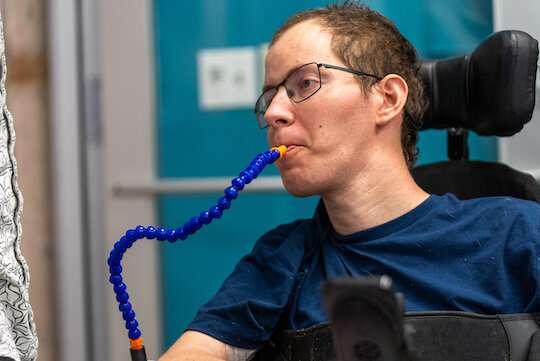This article has been reviewed according to Science X's editorial process and policies. Editors have highlighted the following attributes while ensuring the content's credibility:
fact-checked
trusted source
proofread
Robotic cup helps wheelchair-bound users stay hydrated

Mobility impairments such as those caused by cerebral palsy make it hard for people to perform even simple tasks like drinking a sip of water.
Gary Lynn, a Houstonian living with the condition, turned to Rice University's Oshman Engineering Design Kitchen (OEDK) for help making the idea of an assistive-drinking device a reality. Rice undergraduate engineering students Thomas Kutcher and Rafe Neathery rose to the challenge, and the result is RoboCup—a robotic device that enables people with limited mobility to stay hydrated without help.
"We wanted to make it possible for people with cerebral palsy or similar mobility challenges to drink water autonomously rather than needing to rely on caregiver assistance," said Kutcher, who is a bioengineering major. "The device is designed for wheelchair users who might have trouble holding a cup, and our hope is that it will grant users greater freedom."
Anyone with access to a 3D printer can assemble their own RoboCup by downloading the instructions, which are available for free at team RoboCup's OEDK website. Kutcher and Neathery weighed questions of intellectual property and entrepreneurship in their effort to ensure the result of their work would be useful and accessible to those who need it. In the end, they decided to make RoboCup freely available.
RoboCup can be mounted on users' wheelchairs and customized to best serve their mobility needs. The battery-powered device is activated either via a proximity sensor or a button, depending on users' needs or preferences.
"We asked professionals working with people who have needs similar to Gary's about what we could do to improve the device," Kutcher said. "They really liked our project and confirmed its potential, but they also pointed out that in order to reach as many people as possible, we needed to incorporate more options for building the device, such as different types of sensors, valves and mechanisms for mounting the device on different wheelchair types."
Making the device more accessible also meant simplifying it. The team removed some of the more complicated or expensive parts and found alternatives for custom parts that required special equipment to be manufactured.
"It was a challenge walking that thin line between simplifying the device and sacrificing functionality or robustness," said Neathery, who is a mechanical engineering major. "We wanted to keep it working well while still making it simpler and cheaper. Balancing all these considerations was really tricky, but we did get to a point where it's now a lot easier to 3D print and assemble the device using simple, readily accessible tools."
The students worked closely with Lynn to optimize the design, which went through several iterations. An initial prototype featured a camelback but was scrapped for the mounted cup-and-straw version, which Lynn said looked better and interfered less with locomotion.
"The current design was more appealing to Gary, and we think it'll be more appealing to other users as well," Neathery said.
"This team—our students and Gary—were so persistent and willing to keep modifying the design until they got a workable system," said Maria Oden, a professor of bioengineering, OEDK director, co-director of the Rice 360° Institute for Global Health and the team's mentor. "Our engineers were willing to take hard feedback from Gary when the device did not work as well as we hoped and keep at it until they got a design that is much improved. In addition, they wanted to make sure that the design was accessible to those who wanted to make one."
Both Gary and his mother Andrea Lynn expressed their hope that the project brings attention to the struggles of people living with disabilities who have a hard time with something as easy as drinking water.
"This cup will give independence to people with limited mobility in their arms," Gary Lynn said. "Getting to do this little task by themselves will enhance the confidence of the person using the device."


















